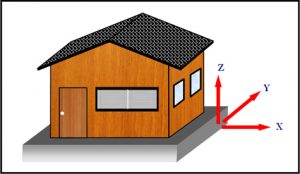
Combining Horizontal and Vertical Earthquake Effects
Answer: The IBC defines E by reference to Section 12.4 of ASCE 7. As shown below, this section provides load combinations that account for vertical earthquake effects by increasing the dead load factor in the additive seismic load combination by considering vertically downward earthquake effects and by decreasing the dead load factor in the counteractive load combination by considering vertically upward earthquake effects. In each case, that is the conservative thing to do. Additive load combinations are where gravity effects add to earthquake effects. For example, gravity causes negative bending moments at the support section of a beam; earthquake forces also cause negative moments at the same support section of the same beam. Counteractive load combinations are where gravity effects counteract earthquake effects. For example, gravity still causes negative moment moments at the same support section of the same beam, but earthquake forces have now reversed themselves; they now cause negative bending moments at the same location. Please note that the above requirement makes the dead load factor of the IBC/ASCE 7 a function of the seismicity (value of SDS) at the site of the structure.
Strength Design Basic Load Combinations:
a. 1.2D + L + 0.2S + E ……where E = ρQE + 0.2SDSD
→ (1.2 + 0.2SDS)D + L + 0.2S + ρQE
b. 0.9D + 1.6H + E ……where E = ρQE – 0.2SDSD
→ (0.9 – 0.2SDS)D + 1.6H + ρQE
Allowable Stress Design Basic Load Combinations:
a. D + H + F + 0.7E ……where E = ρQE + 0.2SDSD
→ (1.0 + 0.14SDS)D + H + F + 0.7ρQE
b. D + H + F + 0.75L + 0.75(Lr or S or R) + 0.75(0.7E) ……where E = ρQE + 0.2SDSD
→ (1.0 + 0.10SDS)D + H + F + 0.75L + 0.75(Lr or S or R) + 0.525ρQE
c. 0.6D + 1.6H + E ……where E = ρQE – 0.2SDSD
→ (0.6 – 0.14SDS)D + H + 0.7ρQE
Strength Design Basic Load Combinations with Overstrength Factor:
a. 1.2D + L + 0.2S + Em ……where Em = Ω0QE + 0.2SDSD
→ (1.2 + 0.2SDS)D + L + 0.2S + Ω0QE
b. 0.9D + 1.6H + Em ……where Em = Ω0QE – 0.2SDSD
→ (0.9 – 0.2SDS)D + 1.6H + Ω0QE